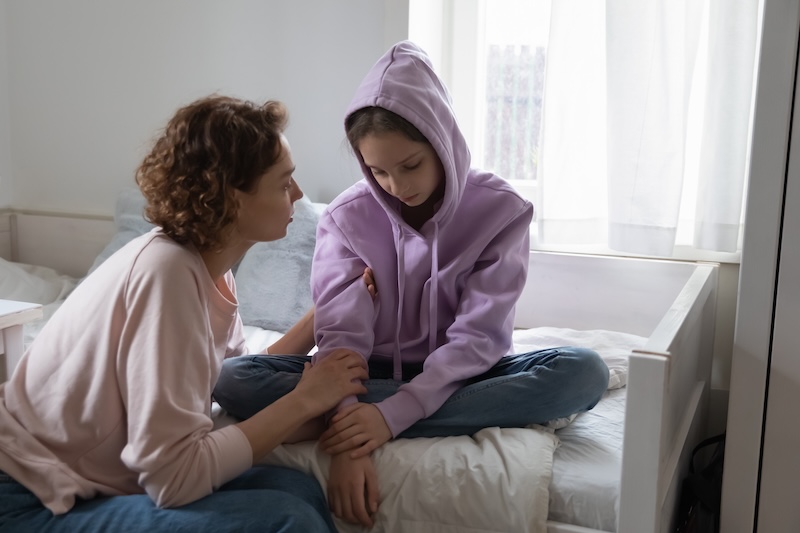Breaking the Cycle: How Attachment Styles Shape Adolescent Girls
When your daughter struggles with relationships, acts out unexpectedly, or pushes away those closest to her, there’s often a deeper reason. Attachment theory, pioneered by psychologist John Bowlby, explains how early relationships with caregivers create patterns that shape how we connect with others throughout our lives.
At Orama Residential Treatment Center, we work with families who discover that attachment styles hold the key to understanding their daughter’s behavioral challenges. What makes Orama different is our commitment to addressing root causes through attachment-informed therapy that transforms families, not just individual girls.

The Four Attachment Styles
Every person, including you as a parent, develops one of four attachment styles based on their early caregiving experiences. Understanding which style describes both you and your daughter is the first step toward understanding behavior patterns and breaking unhealthy cycles.
Secure Attachment
People with secure attachment feel confident in relationships, manage emotions effectively, and trust that others will be available for them. They can ask for help, express emotions appropriately, and handle stress with resilience. Securely attached individuals engage well in relationships and navigate challenges with steadiness.
Anxious Attachment
People with anxious attachment desperately fear abandonment and constantly seek reassurance. They may cling to others, struggle with feelings that nobody truly loves them, and panic at any sign of rejection. Often, they’ll do anything to avoid being alone, which can lead to unhealthy relationships and risky behaviors. At the core is profound insecurity rooted in inconsistent or emotionally unavailable caregiving.
Avoidant Attachment
Those with avoidant attachment protect themselves by pushing people away before they can be hurt. They minimize emotions, seem overly independent, and avoid close relationships. What appears as confidence is often a defense mechanism. People with this style learned early that vulnerability equals pain, so they guard their hearts carefully.
Disorganized Attachment
This attachment style develops when a primary caregiver was both a source of comfort and fear. People with disorganized attachment don’t have a consistent strategy for getting their needs met, so they vacillate between clinging and rejecting the same person. They struggle with emotional regulation and have difficulty trusting anyone.
How Parents Pass Attachment Patterns Forward
Here’s something that shifts everything for parents: your attachment style directly influences how you parent and, ultimately, your daughter’s attachment security. This is called intergenerational transmission. Understanding your own attachment style is just as important as understanding your daughter’s because your patterns shape how you respond to her needs.
If you have insecure attachment, you’re likely operating from your own wounds. You may struggle to be emotionally available, responsive, or attuned to your daughter’s needs. When parents can’t manage their own emotions, they can’t effectively help their children regulate theirs. If a parent becomes dysregulated by their child’s distress, anxiety overrides their ability to soothe. Instead of teaching emotion skills, they model emotional chaos.
The good news? You don’t have to stay trapped in this cycle. At Orama, we work with parents on their own attachment healing, recognizing that true family transformation requires parents to examine and shift their own patterns. Many parents realize they’re parenting from the same insecure patterns their own parents used, and with support, they can do things differently.
How Residential Treatment Creates Change
Attachment healing must be relational. Our staff create consistent, emotionally safe environments combined with intensive therapeutic work. We create what we call “corrective emotional experiences” where insecurely attached girls learn that relationships can be safe and predictable.
A girl with anxious attachment learns she can separate from a trusted adult and that person will still be there. A girl with avoidant attachment discovers that vulnerability doesn’t lead to judgment or abandonment. A girl with disorganized attachment experiences adults who remain calm, consistent, and present even during difficult moments.
These experiences, repeated consistently over time, literally help rewire how your daughter approaches relationships. Trust becomes possible. Emotions feel manageable.
Family therapy is central to our approach. Parents participate in sessions where they learn about their daughter’s attachment style, gain insight into their own patterns, and practice new ways of responding. When daughters see their parents becoming more emotionally available and managing their own emotions effectively, healing accelerates. Girls also build secure relationships with peers within our community, practicing healthy relating day after day.
Getting Started
If your daughter struggles with relationships, emotional regulation, risky behaviors, or seems emotionally withdrawn, attachment patterns may be at the core. Orama Residential Treatment Center specializes in attachment-informed care for adolescent girls. Our clinical team understands that every girl’s behavior makes sense in context and that true healing happens when family systems transform together.
Ready to break the cycle and build your family’s secure future? Contact Orama Residential Treatment Center today. Our admissions team can discuss your daughter’s unique needs, explain our attachment-informed treatment model, and answer your questions.
Contact us today to speak with an admissions counselor who understands both your daughter’s struggles and your hopes for her future.
